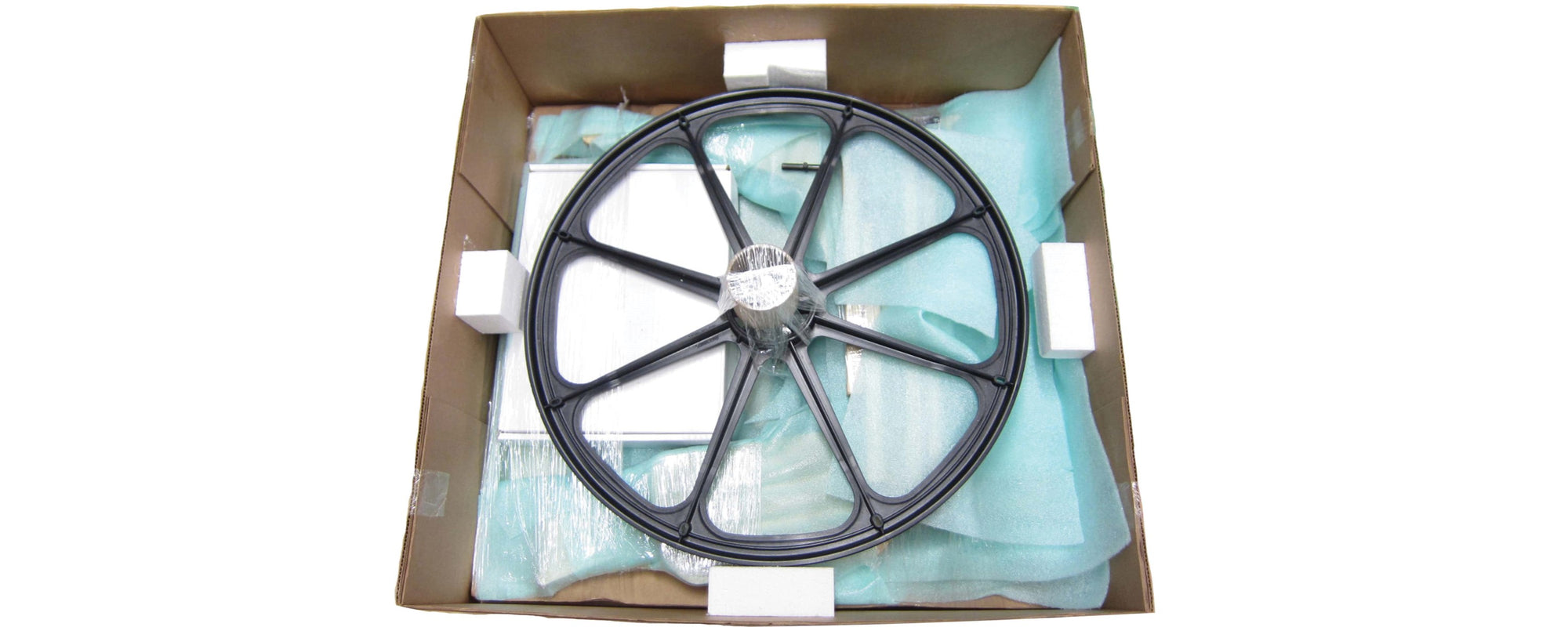By Beth Smith
I was one of the lucky few to have had an opportunity to see and try the Schacht Flatiron several times during its development. Honestly, even the first time I saw that initial prototype with its treadles at an awkward angle and a mother-of-all that needed work, I knew the wheel would be a winner. I knew it because I knew there was a hole in the market for a wheel just like this one. I knew it because I have worked with Schacht for long enough to know that no new Schacht product is introduced to the public until everything has been done to make it as perfect as possible.
Every time I had tried out the Flatiron, it was assembled. So, when my own personal Flatiron showed up, I had no idea what I would find inside the box. In my life, I have probably assembled nearly 500 spinning wheels for customers. Other than the flyer, bobbins and drive wheel, the contents of the Flatiron box did not resemble any of those wheels. When you get it you need to throw away everything you know about spinning wheels and just be prepared to follow the directions and diagrams step by step, as well as follow along with the video instructions on Youtube. If you are a shop owner, the first one will take a little while, but after that it all becomes clear.
There were several times as I was assembling the wheel and seeing what I was building that I actually said out loud, “This is so smart!” And the smarts is what makes it able to be assembled as a left or right hand flyer wheel. There is no other Saxony style wheel on the market today that I know of that can be assembled either way. And there are only two major wheel makers that I know of, and Schacht is one of them, that offers a Saxony wheel with the flyer on the left or right.
As far as performance goes, this wheel is pretty wonderful. Here is a spinning wheel with a drive wheel that is 22 1/2”. That’s a wheel big enough to get some serious production spinning done. But with the range of whorls available from 4.6 to 26:1, this wheel can spin everything from gossamer to bulky yarns.
The treadling is smooth and light. If you are a person who likes to treadle with only one foot, no problem. Even with the double treadles, it is easy to use just one foot. The lightness of the wheel, combined with the engineering put into it, makes it easy to start and stop and control.
The wheel comes with a stretchy drive band as well as cotton drive band so, like with the range of whorls sizes and ratios available, this wheel is super adjustable and can be set up in Scotch tension (flyer led), Irish tension (bobbin lead) and double drive.
Once you have everything assembled and aligned correctly, adjusting the wheel for spinning is magical. The tension knob can make minute adjustments which reduces the amount of time spent setting the wheel up to spin your next yarn and allows tiny adjustments while spinning to result in an ease of spinning that can be hard to find with other spinning wheels.
If you are new to using a Saxony style wheel, finding the right way to sit at the wheel might take a bit of maneuvering. Use the angle of the treadles as a clue. See how they are directed toward the back maiden of the mother-of-all? When you sit in your chair, place the wheel so that your feet are aligned with the treadles. This will mean that the mother-of-all is slightly further away from you than the drive wheel. This will give you a bit more room between your hands and the orifice so that there is time to work and a little bit of space for the twist to even out a bit. The more space between the orifice and your hands the better.
Make sure you are sitting straight and not twisting your body toward the orifice. One of the great things about spinning is that twist will work its way around corners so if the yarn is not coming straight out of the orifice it’s no big deal. And now, when you want to do long draw or supported long draw you can draft across the front of your body and avoid any strain that might come from spinning on a wheel with the orifice positioned directly in front of you.
All of this can be a bit of an adjustment if you aren’t used to spinning on this style of wheel, but the changes are worth it, especially if you plan to do any kind of spinning for a large project.
Just one more thing, this wheel comes with the Schacht travel bobbins. If you have any of the Schacht wooden bobbins sitting around, give them a go for an even better feeling. You won’t be sorry.
I’ve watched this wheel grow from just the beginnings of a design to a wheel that I love to spin on in my own home. As excited as I was about it that first time I saw that awkward first prototype, I had no idea that it would be such a great wheel.
Beth Smith is a spinner, weaver, teacher, and author of The Spinner’s Book of Fleece and How to Spin. Beth teaches weaving around the US and is on the advisory board of Ply magazine. You can read her blog at http://bethsmithspinning.com/blog/ Beth lives in Howell, Michigan.

